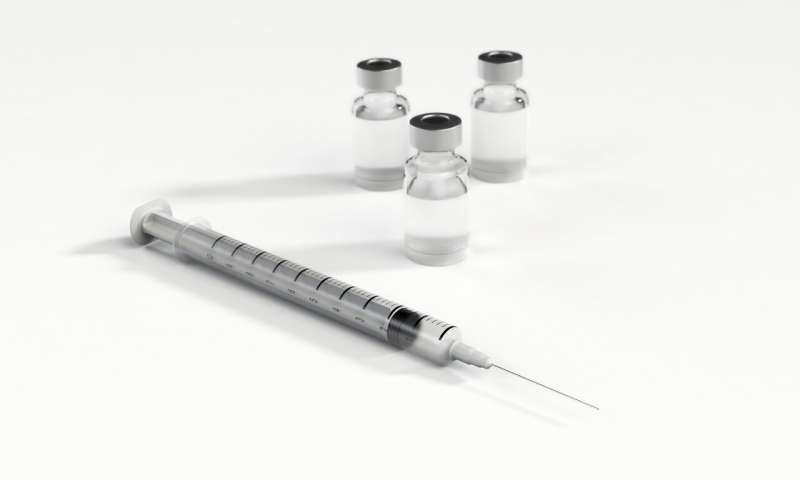February 27, 2024 feature
This article has been reviewed according to Science X's editorial process and policies. Editors have highlighted the following attributes while ensuring the content's credibility:
fact-checked
peer-reviewed publication
trusted source
proofread
Elusive immune cells dwelling in 'hidden niches' of the bone marrow may be key to SARS-CoV-2 vaccination

Although immunologists have developed a deep reservoir of knowledge illuminating how antibodies respond to vaccination against SARS-CoV-2, little is known about the elusive cells that produce infection-fighting antibodies.
Despite antibodies being among the first responders when infectious agents invade the body, they're produced by mystifying cells that are complicated by two things: residence in a hidden niche and possessing a convoluted name—long-lived plasma cells, or simply LLPCs.
The trouble with developing a more intimate knowledge of LLPCs is that they dwell deep in the bone marrow in specialized compartments and are difficult to study in humans. A plasma cell develops from an immune system B cell and is a type of white blood cell.
Having a better understanding of these cells would not only aid the development of better vaccines but would bolster scientific understanding of the immune system itself. Now, a new round of research has both dispelled some of the mystery about LLPCs, and at the same time, has opened a new window of understanding into vaccination against SARS-CoV-2.
What scientists wanted to know is how these mystifying cells respond to SARS-CoV-2 vaccination and whether the team could develop a technique to trace and document the inoculation response. In so doing, researchers would have firsthand evidence of the cascade of molecular events occurring deep within the bone marrow in response to SARS-CoV-2 immunization.
The team of researchers hailed from several centers in the United States and was led by scientists at the Vaccine Research Center of the National Institute of Allergy and Infectious Diseases in Bethesda, Maryland.
"We believe that [our technique] provides the technical knowledge required to study this extremely critical yet sparsely studied immunological compartment that mediates long-term serological immunity," lead author Madhu Prabhakaran wrote in Science Translational Medicine.
LLPCs originate in the body's germinal centers, which are highly specialized sites in lymphoid tissue. But these LLPCs literally pack up and leave—relocating to "survival niches" in the bone marrow where they take up residence, persisting in these hideaways for decades. From their survival niches, LLPCs secrete antibodies and help guard against infection over long periods of time.
It is because of their persistence that long-lived plasma cells can offer insights into how well any given vaccine is inducing antibodies and immunity. Yet, it is also because LLPCs migrate to tucked away sites that it has been extraordinarily difficult to study them.
With a newly devised technique that they developed, Vaccine Research Center scientists and their collaborators report being able to detect and capture LLPCs that produced antibodies against a specific pathogen, in this case, SARS-CoV-2.
Writing in Science Translational Medicine, Prabhakaran and collaborators report that they used "an antigen-specific LLPC isolation technique," a way of capturing the elusive cells. The team then purified SARS-CoV-2 spike protein and receptor binding domain-specific LLPCs "from the bone marrow of lab animals and determined that their antibody repertoires matched those of memory B cells in the peripheral blood."
Prior to the research by Prabhakaran and colleagues said it was unclear whether SARS-CoV-2 spike protein vaccination was able to elicit and maintain LLPCs. But with a highly sensitive method to identify and isolate antigen-specific LLPCs by tethering antibodies secreted by these cells onto the cell surface, Prabhakaran and colleagues made a tantalizing discovery: The team found that it takes more than one dose of adjuvanted SARS-CoV-2 spike protein vaccine to induce spike protein-specific LLPC reservoirs. The study was conducted in nonhuman primates.
"Using this method, we found that two doses of adjuvanted SARS-CoV-2 spike protein vaccination are able to induce spike protein-specific LLPC reservoirs enriched for receptor binding domain specificities in the bone marrow of nonhuman primates that are detectable for several months after vaccination," Prabhakaran wrote. "Many of the antibodies secreted by these LLPCs also exhibited improved neutralization and cross-reactivity."
The technique devised by Prabhakaran and colleagues demonstrated that antibodies produced by LLPCs can be readily detected in the laboratory. The nonhuman primate in the research that helped the team develop and hone their technique was rhesus macaques.
The animals received an adjuvanted vaccine based on the spike protein of SARS-CoV-2. Over an eight-month longitudinal study, the team discovered how doses of the vaccine-induced reservoirs of LLPCs specific to the spike protein, which produced powerful neutralizing antibodies.
In their paper, the team said that questions remain about how precisely LLPCs are seeded and maintained, hence the need for further studies, they said.
"These findings establish our method as a means to sensitively and reliably detect rare antigen-specific LLPCs and additionally demonstrate that adjuvanted SARS-CoV-2 spike protein vaccination establishes spike protein-specific LLPC reservoirs," Prabhakaran concluded.
More information: Madhu Prabhakaran et al, Adjuvanted SARS-CoV-2 spike protein vaccination elicits long-lived plasma cells in nonhuman primates, Science Translational Medicine (2024). DOI: 10.1126/scitranslmed.add5960
© 2024 Science X Network




















